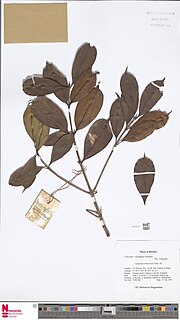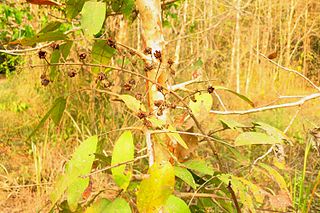
Cratoxylum arborescens is a plant in the family Hypericaceae. The specific epithet arborescens is from the Latin meaning "tree-like".

Cratoxylum cochinchinense is a plant now placed in the family Hypericaceae. The specific epithet cochinchinense is from the Latin meaning "of Cochinchina". In Vietnamese C. cochinchinense is usually called thành ngạch nam or lành ngạnh nam, other names include: hoàng ngưu mộc, hoàng ngưu trà and đỏ ngọn.

Cratoxylum maingayi is a plant in the family Hypericaceae. It is named for the botanist Alexander Carroll Maingay.
Ailanthus integrifolia, white siris, is a tree in the family Simaroubaceae. The specific epithet integrifolia is from the Latin meaning "entire leaves", referring to the leaflet margins.
Anisophyllea beccariana is a tree of tropical Asia in the family Anisophylleaceae. It is named for the Italian botanist Odoardo Beccari.
Anisophyllea corneri is a tree of tropical Asia in the family Anisophylleaceae. It is named for the English botanist Edred John Henry Corner.
Anisophyllea disticha is a plant of tropical Asia in the family Anisophylleaceae. The specific epithet disticha is from the Latin meaning "2-ranked", referring to the leaf arrangement.
Canarium littorale is a tree found in tropical Asia and is a member of the incense tree family Burseraceae. The specific epithet littorale is from the Latin meaning "of the seashore", referring to its habitat.
Canarium patentinervium is a tree of tropical Asia in the incense tree family Burseraceae. The specific epithet patentinervium is from the Latin meaning "spreading nerves", referring to the leaf veins.
Licania splendens is a tree in the family Chrysobalanaceae. The specific epithet splendens is from the Latin meaning "shining", referring to surfaces of the dried leaves.
Maranthes corymbosa is a tree in the family Chrysobalanaceae. The specific epithet corymbosa is from the Greek meaning "cluster", referring to the clustered inflorescences.
Mastixia macrocarpa is a tree in the family Nyssaceae. The specific epithet macrocarpa is from the Greek meaning "large fruit".
Radermachera ramiflora is a tree in the genus Radermachera of the family Bignoniaceae. The specific epithet ramiflora is from the Latin meaning "flowering on the branches".
Dipterocarpus oblongifolius grows as a tree up to 30 metres (100 ft) tall, with a trunk diameter of up to 1.5 metres. Bark is greyish brown. The fruits are ovoid to spindle-shaped, up to 3 cm (1 in) long. The specific epithet oblongifolius is from the Latin meaning "oblong leaves". Habitat is river banks from sea-level to 400 metres (1,300 ft) altitude. D. oblongifolius is found in Thailand, Peninsular Malaysia and Borneo.
Deplanchea bancana is a tree in the family Bignoniaceae. It is named for Sumatra's Bangka Island.
Dacryodes costata is a tree in the family Burseraceae. The specific epithet costata is from the Latin meaning "ribbed", likely referring to the prominent veins on the leaf underside.
Dacryodes laxa is a tree in the family Burseraceae. The specific epithet laxa is from the Latin meaning "loose", referring to the inflorescence.

Dacryodes rostrata is a tree in the family Burseraceae. The specific epithet rostrata is from the Latin meaning "beaked", referring to the narrow-tipped leaves.
Maclurodendron porteri is a tree in the family Rutaceae.
Castanopsis javanica, the Javan chestnut-oak, is a tree in the beech family Fagaceae. The specific epithet javanica is from the Latin, meaning "of Java".




